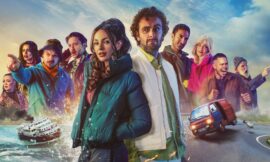Introduction
The 2019 film Robert the Bruce is a historical drama that serves as a continuation of the legendary Scottish hero’s story, following the events of Braveheart (1995). The film, directed by Richard Gray, stars Angus Macfadyen, reprising his role as Robert the Bruce, the famous Scottish king who fought for independence against England in the 14th century. Unlike Braveheart, which focused on the rebellion of William Wallace, Robert the Bruce shifts the focus to the struggles, resilience, and humanity of the titular character. This article explores the film’s historical accuracy, narrative structure, character development, cinematography, and reception.
Plot Summary
The film is set in 1306, during a turbulent time when Scotland was in the midst of its war for independence. Robert the Bruce, after claiming the Scottish throne, finds himself abandoned by his allies and hunted by English forces. Weakened and on the run, he is given shelter by a poor widow, Morag (played by Anna Hutchison), and her children, who nurse him back to health. As he recovers, he forms a bond with the family, and this rekindles his determination to fight for Scotland’s freedom. The story, while centering on Robert the Bruce, also highlights the struggles of common Scots during the war and the impact of his leadership on their lives.
Character Development
Robert the Bruce (Angus Macfadyen)
Robert is portrayed as a weary and almost broken man who has lost faith in his cause. The film moves away from the traditional depiction of heroic warriors constantly leading battles. Instead, it presents a more introspective character, one who must find his inner strength to continue fighting. Macfadyen’s performance brings depth to Robert’s character, showing a vulnerable yet resilient leader who inspires people not just through war but through his perseverance and commitment to Scotland’s freedom.
Morag (Anna Hutchison)
Morag represents the spirit of ordinary Scots who suffered under English rule. She is a widow struggling to protect her family but is willing to take in Robert despite the risks. Her character symbolizes the unsung heroes of history—the people who fought in different ways, not on the battlefield but in their daily struggles. Through her interactions with Robert, she reignites his hope and purpose.
Angus McDonald (Diarmaid Murtagh)
Angus is one of the Scottish warriors torn between fear and loyalty. He embodies the internal conflict that many Scots faced during this time—whether to risk everything for independence or to succumb to English rule. His character arc complements Robert’s journey, showcasing how inspiration and leadership can spread among the people.
The Antagonists
Unlike Braveheart, Robert the Bruce does not emphasize a singular English villain like Edward I. Instead, the conflict is more personal, focusing on Scottish infighting and the challenge of maintaining unity in a country divided by fear and oppression.
Historical Accuracy
One of the film’s strengths is its attempt to stay true to historical events while adding dramatic elements. However, as with most historical dramas, some liberties are taken. The film portrays Robert the Bruce as being completely alone at his lowest point, but in reality, he still had some loyal followers. Additionally, the timeline of events is somewhat compressed for cinematic purposes.
The depiction of Robert’s time in hiding aligns with historical accounts suggesting that he went into exile after suffering defeats against the English. The film also highlights the involvement of common Scots in the independence movement, which is historically accurate, though often overlooked in mainstream media.
Themes and Symbolism
Survival and Resilience
The film’s primary theme is survival, both personal and national. Robert’s struggle mirrors Scotland’s own fight for independence—both are beaten down but refuse to surrender. His slow recovery represents the resurgence of Scottish resistance, making the film as much about emotional endurance as it is about war.
The Role of Common People in History
Unlike Braveheart, which focuses on grand battles and political intrigue, Robert the Bruce emphasizes the impact of ordinary citizens. Morag and her family’s role in aiding Robert signifies how every small act of defiance contributed to Scotland’s ultimate victory.
Leadership and Legacy
Robert’s transformation from a defeated man to a determined leader reinforces the idea that great leaders are shaped not just by victories but also by hardships. The film suggests that Robert’s time with Morag and her family was instrumental in shaping his approach to ruling Scotland.
Cinematography and Visuals
The film features breathtaking cinematography, capturing the rugged beauty of Scotland. The snow-covered landscapes and dense forests reflect the harsh conditions Robert endured. The use of natural lighting adds to the film’s authenticity, making the audience feel immersed in medieval Scotland.
Unlike large-scale Hollywood epics, Robert the Bruce relies on intimate, close-up shots to emphasize character emotions. The battle scenes are sparse and more focused on personal combat rather than large-scale warfare, aligning with the film’s introspective tone.
Reception and Criticism
Upon its release, Robert the Bruce received mixed reviews from critics and audiences. Some praised its character-driven approach and historical depth, while others felt it lacked the action and intensity of similar medieval war films.
Praise
- Angus Macfadyen’s performance was widely praised for its depth and authenticity.
- The cinematography was highlighted as one of the film’s strongest aspects, effectively showcasing Scotland’s landscapes.
- The focus on common people was appreciated for adding a unique perspective to the story.
Criticism
- Pacing Issues – Some viewers found the film slow, especially compared to more action-oriented historical films.
- Lack of Large-Scale Battles – Those expecting grand war sequences similar to Braveheart were left disappointed.
- Limited Scope – The film’s intimate setting meant that it did not explore the full scale of Robert the Bruce’s military campaigns.
Comparison to Other Films
While Braveheart is an epic, action-heavy film, Robert the Bruce takes a more subdued, character-driven approach. In contrast to Outlaw King (2018), which starred Chris Pine as Robert the Bruce and featured large-scale battles, Robert the Bruce focuses more on the personal struggles of its protagonist. Each film presents a different aspect of the Scottish fight for independence, making them complementary rather than competing narratives.
Conclusion
Robert the Bruce (2019) offers a fresh perspective on one of Scotland’s most revered historical figures. By focusing on his lowest point and his resurgence, the film provides a deeper, more humanized portrayal of the king. While it may not have the grand battles of Braveheart or Outlaw King, it succeeds in telling an intimate, character-driven story of resilience, leadership, and national pride.
Despite some pacing issues and mixed critical reception, the film remains an important addition to historical cinema, shedding light on the often-overlooked aspects of Robert the Bruce’s journey. Whether you are a history enthusiast or simply enjoy thought-provoking dramas, Robert the Bruce is worth watching for its unique storytelling and stunning cinematography.



